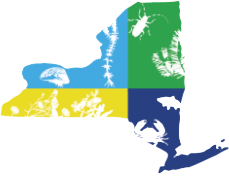
New York Invasive Species Research Institute
Biocontrol: Path to Approval
Biological control programs are one of the best, and quite often the only, long-term solution to managing invasive plants and animals. In order to be introduced in the state, biological control agents must first be federally approved.
The Path to Approval
-
Identify Agents
Many years of research are required to develop a candidate species for biocontrol. For classical biocontrol programs, the process of identifying agents begins in the native range of the pest species. Surveys are conducted to identify all insects and pathogens found feeding on, parasitizing, or living upon the pest species. Results from these surveys inform a list of candidates, which undergo further testing to ensure no other non-target organisms are fed upon or predated.
-
Generate List
In the United States, USDA APHIS is responsible for reviewing petitions to release biocontrol agents. When developing a biocontrol for a plant pest, researchers first submit a list of plant species against which they intend to test candidates to a Technical Advisory Group (TAG). Feedback provided by the TAG is used to generate a formalized list, which typically includes a range of native species, as well as economically valuable species (ie. crops).
-
Host Tests
Researchers then conduct host-specificity and host-preference tests. Host specificity tests determine whether the agent is able to survive upon any of the non-target species when no other food source is available. Host preference tests offer agents a choice between target and non-target species and assess an agent’s fidelity to the target species.
-
Permits
During the testing stage, biocontrol agents may be moved into the U.S., where they must be kept in special quarantine facilities. Bringing potential agents into the country requires a permit from theAPHIS Plant Protection and Quarantine (PPQ) Program.
-
Decision
Once the appropriate tests have been conducted, researchers may submit a petition to release to the Technical Advisory Group, which may request further experiments, or recommend releasing or not releasing an agent. Researchers must also work with the U.S. Fish and Wildlife Service to consider and assess potential impacts to threatened and endangered species in this process.USDA APHIS PPQ considers the sum of the recommendations from USFWS and the TAG to either issue a permit for release, request an environmental impact statement, or recommend the project be discontinued.
